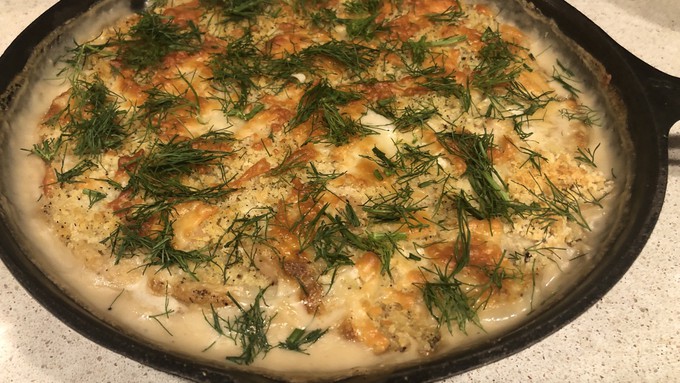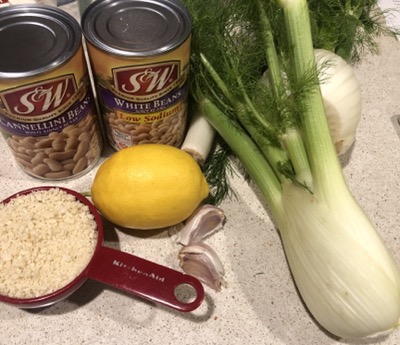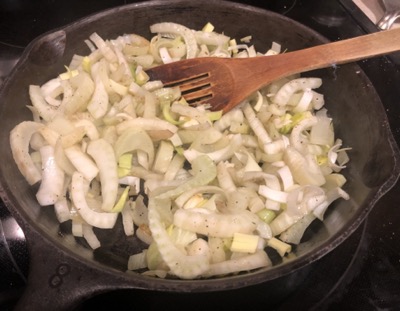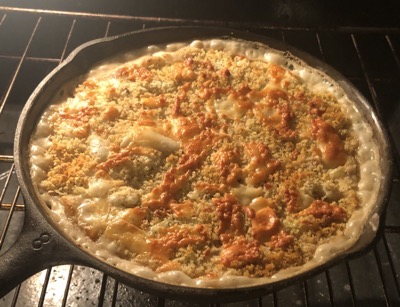
Recipe: Creamy casserole ideal for a winter meal

Out of the oven and topped with fresh fennel fronds, this casserole works as a vegetarian entree or can serve as a side dish to any meat. Kathy Morrison
Fennel is one of those plants that can be categorized as a vegetable, herb or spice, depending on which part is used. The bulb can be sliced into salads raw, or sautéed or baked, while the fronds can add depth to salads, and the seeds are used in many savory cooked dishes.

My farm box fennel inspired a hunt for new recipes, and the one here (found on the New York Times Cooking site) was a perfect warming combination for these cold February nights. The raw veggie is mildly licorice-tasting, but baked it mellows considerably. We enjoyed the casserole alongside grilled pork chops and steamed broccoli, but the beans-fennel-cheese combo would be an excellent vegetarian entree, served with a green salad and some whole wheat bread.
Notes: I used one can of cannellini beans and one of navy beans, since either works. I think the smaller beans puree more easily, but go with what you have. Also, I forgot to add the Parmesan shreds to the bread-crumb topping before putting it on the beans, so I sprinkled it on top, which worked just fine. The fennel-fronds garnish adds visual interest and a flavorful zing to the dish.
Any white bean and fennel casserole
Serves 4 to 6
Ingredients:
6 tablespoons olive oil, divided
2 large fennel bulbs
Salt and freshly ground black pepper
2 garlic cloves, minced
1 leek, white and light green part only, trimmed and thinly sliced, optional
2 (14-ounce) cans white beans, such as cannellini, navy or great Northern
1/2 cup heavy cream, half and half or whole milk

Zest from 1 lemon, divided
2 tablespoons fresh lemon juice
1/2 cup panko bread crumbs
1/2 cup or more grated or shredded Parmesan cheese
Instructions:
Heat the oven to 425 degrees. Trim the stalks and tough root end from the fennel bulb, reserving some of the fresh fronds for garnish. Cut the bulbs in half lengthwise, then in thin slices across.
Heat 2 tablespoons olive oil in a large, heavy oven-safe skillet over medium heat. Add the sliced fennel, seasoning with salt and pepper, and sauté until softened but not limp, 10-12 minutes. Stir in the garlic and, if using, the leek, and cook, stirring, another 1 or 2 minutes.
To prepare the sauce, pour 1 can of beans and its liquid into a blender. Pour in the cream or milk, 2 tablespoons olive oil, the lemon juice and 1/2 teaspoon of the lemon zest. Purée until smooth.
Drain and rinse the other can of beans in a colander. Stir the rinsed beans and the puréed mixture into the skillet with the cooked fennel. Season well with salt and freshly ground pepper.
For the topping: Place the panko crumbs in a small bowl with the remaining 2 tablespoons olive oil. Stir in the remaining lemon zest, the Parmesan and more pepper, and toss to coat. Sprinkle the crumb mixture over the beans and fennel in the pan.

Bake the casserole until bubbling and golden on top, about 15 minutes. (Broil the top 1-2 minutes more if you want it crisper.) Roughly chop the reserved fennel fronds, sprinkle them over the casserole, and serve.
Comments
0 comments have been posted.Sacramento Digs Gardening to your inbox.
Sites We Like
Garden Checklist for week of July 21
Your garden needs you!
* Keep your vegetable garden watered, mulched and weeded. Water before 8 a.m. to reduce the chance of fungal infection and to conserve moisture.
* Feed vegetable plants bone meal, rock phosphate or other fertilizers high in phosphate to stimulate more blooms and fruiting. (But wait until daily high temperatures drop out of the 100s.)
* Don’t let tomatoes wilt or dry out completely. Give tomatoes a deep watering two to three times a week.
* Harvest vegetables promptly to encourage plants to produce more. Squash especially tends to grow rapidly in hot weather. Keep an eye on zucchini.
* Pinch back chrysanthemums for bushy plants and more flowers in September.
* Remove spent flowers from roses, daylilies and other bloomers as they finish flowering.
* Pinch off blooms from basil so the plant will grow more leaves.
* Cut back lavender after flowering to promote a second bloom.
* It's not too late to add a splash of color. Plant petunias, snapdragons, zinnias and marigolds.
* From seed, plant corn, pumpkins, radishes, winter squash and sunflowers.